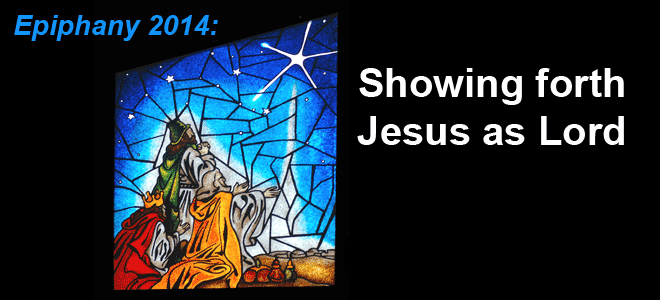 The Baby born at Christmas was without doubt God and Lord, but not everyone knew at first. Sure, the angels told the likely-Jewish shepherds the night of His birth, and other faithful Jews realized it within 40 days, but those outside of the chosen people of Israel do not seem to have known until the magi with their gifts confessed Him as King, Priest, and Sacrifice. The season of Epiphany begins by Epiphany day’s marking their coming as a showing forth of Jesus as Lord, continues with other such showings forth, and ends with the greatest example of Jesus revealing His divine nature, the Transfiguration. Of course, the great mystery is that such a glorious God humbled Himself to death on the cross to save sinners by grace through faith in Him!
The Baby born at Christmas was without doubt God and Lord, but not everyone knew at first. Sure, the angels told the likely-Jewish shepherds the night of His birth, and other faithful Jews realized it within 40 days, but those outside of the chosen people of Israel do not seem to have known until the magi with their gifts confessed Him as King, Priest, and Sacrifice. The season of Epiphany begins by Epiphany day’s marking their coming as a showing forth of Jesus as Lord, continues with other such showings forth, and ends with the greatest example of Jesus revealing His divine nature, the Transfiguration. Of course, the great mystery is that such a glorious God humbled Himself to death on the cross to save sinners by grace through faith in Him!
The day of Epiphany itself, January 6th, is sometimes called “Gentiles’ Christmas”, as what we usually think of as non-Jewish magi brought three gifts to the boy Jesus, perhaps as late as two years after He was born (see Matthew 2:1-12). Unfortunately, we at Pilgrim do not hear the events of the day of Epiphany, since we do not presently observe Epiphany on its day nor do we transfer its observance (the preceding Sunday is still in the Christmas season, and the following Sunday in the Epiphany season importantly emphasizes the Baptism of Our Lord).
The First Sunday after Epiphany (January 11th, this year) commemorates The Baptism of Our Lord (Mark 1:4-11). That event is one of the clearest revelations of our Triune God as Father (the voice from heaven), Son (the man Jesus standing in the Jordan River), and Holy Spirit (the dove). And, in being baptized, Jesus sets apart as holy such a washing for our forgiveness of sins. We do not witness the epiphany of the Trinity as did those present there that day, but we have our own epiphanies, as it were, in our baptisms, which connect us to Jesus’s death and resurrection (Romans 6:1-14), and thereby give those who believe the forgiveness of sins and so also eternal life.
The Epiphany season begins and ends with the church using the color white, appropriate for baptism and the light and purity of our Lord, but for the Sundays in between the church uses green, the color of growth, leaves, foliage, fruit, and life, suggesting spiritual growth. Such spiritual growth comes about by the pure preaching of the Gospel and right administration of the Sacraments. As God wills, such spiritual growth also can be accompanied by numerical growth, as He creates faith when and where He pleases in those who hear the Gospel.
The following are the “green” Sundays in Epiphany 2015 and their Gospel Readings (appointed by Lutheran Service Book’s three-year lectionary series B, which largely uses the Holy Gospel according to St. Mark).
- Second Sunday after the Epiphany (1/18): Jesus calls two disciples (John 1:43-51)
- Third Sunday after the Epiphany (1/26): Jesus preaches and calls fishermen as disciples (Mark 1:14-20)
- Fourth Sunday after the Epiphany (2/1): Jesus teaches with authority (Mark 1:21-28)
- Fifth Sunday after the Epiphany (2/8): Jesus heals and casts out demons (Mark 1:29-39)
No matter how many Sundays there are in Epiphany, in Lutheran practice dating back to the Reformation, the last Sunday is always The Transfiguration of our Lord (February 15th, this year). The Transfiguration is the greatest showing forth of Jesus as Lord, right before He sets out in earnest to die on the cross for all people’s sins (Mark 9:2-9).
You are always welcome at Pilgrim in person, but even here online you can read and hear the sermons at Pilgrim from the Season of Epiphany and from every season of the Church Year.
The banner graphic at the top of this page uses an image of the magi following the star that guided them to Jesus found here, on the website of Redeemer Lutheran Church, Woburn, MA (ELCA). There, the image with its stained-glass-window effect is said to have been painted by Fiona Brown of Coburg, Ontario, Canada.

